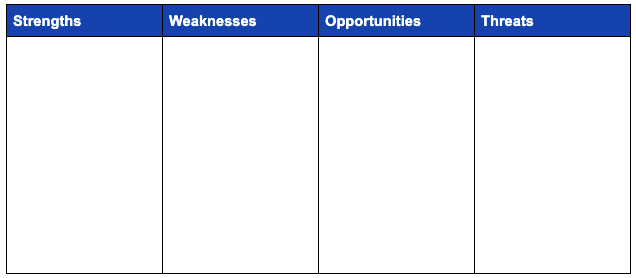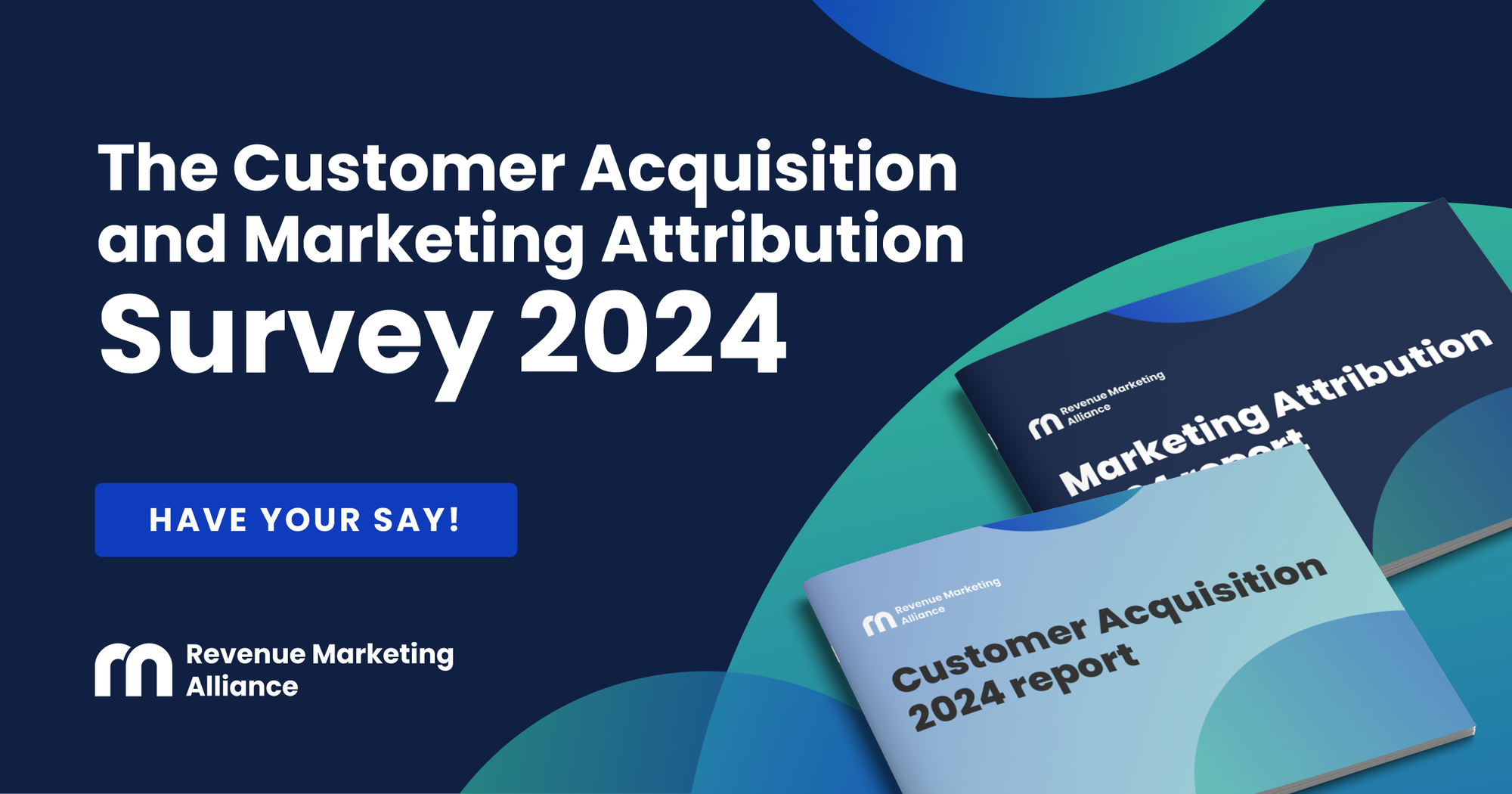Introduction
SWOT analysis is a powerful tool in B2B marketing. It allows you to position your company within your market and make comparisons to competitors. It also allows you to make objective decisions on your strategies.
Most importantly a SWOT analysis is a super simple four-way grid matrix that makes planning and decision-making way easier.
What is a SWOT analysis?
SWOT stands for:
- Strengths
- Weaknesses
- Opportunities
- Threats
Strengths and weaknesses are internal to your firm and allow you to identify what your company does well and what it does less well. Maybe your company has a great email marketing strategy but a poorer social media strategy, or vice versa.
On the other hand, opportunities and threats are external factors and allow you to identify, well, the opportunities and threats in your company’s marketplace. Usually, these relate to your competitors or other elements of the wider business environment.

This framework doesn’t need to be used alone though, don’t be afraid to use other models alongside SWOT. This can aid you in identifying the opportunities and threats in the wider environment.
It’s also important to have a goal or objective when carrying out a SWOT analysis. You might want to know what new campaign you should run next or if using a certain social media platform is actually driving sales. Whatever insight you want to gain from your analysis, write it down and share it with other stakeholders so you can refer back to it.
There are a few steps to a successful SWOT analysis: identifying, ranking, and responding. The remainder of this article will tackle each of these in turn.
Identifying SWOT
When starting a SWOT analysis, it may be easier to tackle each section separately. This allows you to focus better and saves you from jumping between sections, which may lead to a scattered train of thought.
Having an established template is a good idea as it can make the process easier and less overwhelming.
Now that you have your lists set up and ready to go, it’s time to start your analysis - just remember to keep checking back to your goal.
Strengths
Strengths are things your company currently does well. You should include the things that stand out as clear strengths of your company - but don’t forget to also include smaller factors too. All strengths - big and small - will help to give you a clearer image.
Strengths can be on a company-wide level or more specific to your department. On a company-wide level, your strengths would be what you do really well, like customer service or operational efficiency. More specific strengths will likely be about your marketing capabilities, for which you’ll probably want to look at what you’ve done well in other campaigns. Taking both into consideration can be important in planning and developing new campaigns.
Here are some example questions to ask yourself:
- Was your email marketing working well?
- Did you increase engagement? By how much?
- Does your team communicate well? How well does your team communicate with the sales team?
- How was it different from competitors’ marketing?
All of these things may lead you towards strengths in your strategy. Now that you have identified your strengths move on to your weaknesses.
Weaknesses
The method for this stage is similar to the last, but more focused on what your company could work on. What are your competitors doing better than you? Which aspects of your own capabilities need work? Being aware of these weaknesses will allow you to improve your marketing strategy appropriately.
Try not to be overly negative while taking this step, this isn’t blame game time - instead, be objectively critical. Don’t just beat yourself up by listing all the things that have gone wrong ever. This step is more about thinking through these weaknesses to get to the root of the problem (with the ultimate goal to resolve them).
For example, focus on what stops purchases from being finalized or what reduces your team’s productivity. This will be much more helpful than a dramatic declaration that your strategy is terrible and pointing fingers.
Now that you have considered the internal factors affecting your company, it’s time to consider the external environment, starting with opportunities
Opportunities
Opportunities are things you can hope to make use of in the future. Is there a new audience you could target? A major event coming up? A gap in the market you could exploit? Or maybe there’s a new social media platform you could use?
You should consider your goals and weaknesses and brainstorm ways to achieve your goals and resolve some weak points. PESTEL is a good model to help you with this step. You define and categorize the political, economic, socio-cultural, technological, environmental, and legal factors which could be opportunities in the wider environment.
It’s important to think of ways to stand out against your competition - don’t be afraid to go a little wild with your ideas. You might not use all the ideas but it’s a good creative exercise and they’re worth noting down for future reference. You never know when a big crazy idea could come in handy.
Don’t give up yet, you’re almost finished with the identifying stage - just the threats to go.
Threats
It’s easy to feel, well, threatened by threats but don’t panic! SWOT is all about you objectively analyzing and evaluating these issues. In this column write down anything that might stop you from reaching your goal.
An example of a threat might be a strong competitor or new legislation that will affect your company.
Here are some example questions to ask yourself to identify threats:
- Are there any changes in the market that will hinder your plans?
- What obstacles is your company currently facing?
- Is there a technological innovation that will impact your product/service?
- What is happening with your competitors? How will this impact your company?
Now that you have completed your four lists, it is time to move onto the second stage: ranking.
Ranking SWOT
This stage is optional but valuable - it will allow you to see the importance of each element on the list. By ranking each SWOT you can prioritize changes.
It’s up to you how you rank each section, but below are some examples. Remember to consider your goal before deciding on a ranking method. You can generally get by just using a scale of 1-10 for your rankings.
Strengths:
- How strong are you at each item?
- How much does this matter to the customer?
- How far ahead of the competition does this position you?
- To what degree does this help you reach your goal?
Weaknesses:
- How strong (or not so strong) are you at each item? It may be helpful if this is the same scoring system as strengths for comparison (e.g. if you have something that is below a certain threshold, it’s a weakness, or above it’s a strength).
- How difficult would this be to implement changes to?
- To what degree does this stop you from reaching your goal or hinder performance?
Opportunities:
- How important is this opportunity?
- How much time/resources would be required to make use of this opportunity?
- How much of a benefit would this be towards your goal?
Threats:
- How important is this threat?
- How likely is this to happen?
- How easy would it be to avoid this threat?
- How much of a detriment would this be to your goal?
This should give you an idea of how you could rank your SWOT and what areas to prioritize. Now it’s time to put it all together into your matrix and get planning your next steps.
Responding to SWOT
With your SWOT grid in hand, it’s time to work out what it all means. There are four ways to look at items on the list, which will help you develop a response.
- Strength-Opportunity: Your company is strong in this area so it should be easy to take advantage of this opportunity. These are usually quick wins.
- Strength-Threat: This strategy involves making use of company strengths to avoid or diminish threats. This will help prevent threats in the future.
- Weakness-Opportunity: Using opportunities it may be possible to improve upon your weaknesses. These may be harder to carry out but will be impactful.
- Weakness-Threat: This strategy is difficult but can be important in avoiding failure. It involves trying to minimize company weaknesses to avoid threats.
Your responses to each cross-section should be actionable and work towards your goal. Below is a basic example of how this may look.

Conclusion
SWOT analysis works best when done as a team exercise, so you can work together to analyze everything and develop actionable plans. It can be even more beneficial to coordinate with other departments (particularly Sales), so you can get fresh perspectives on what fits under each category.
Psst... now's your chance to influence the most important conversations in revenue marketing
How do leading marketers drive growth? What channels attract and convert customers? Where should budgets be allocated? What metrics matter most?
Our groundbreaking 2024 Customer Acquisition and Marketing Attribution Survey will reveal the inner workings of today's state-of-the-art revenue engines. And you can help uncover the key insights.
The insights gained will be invaluable for staying ahead of rapid changes in 2024.
This is your exclusive opportunity to shed light on:
- Current marketing attribution models and challenges
- The evolving customer journey to purchase
- How teams track and optimize funnel performance
- Emerging strategies to connect with modern buyers
- Key focus areas for growth in 2024
… And a whole lot more.
Take the survey, and at the end, receive a comprehensive Customer Journey framework slide deck to help you and your team acquire more customers with less stress! 👇


